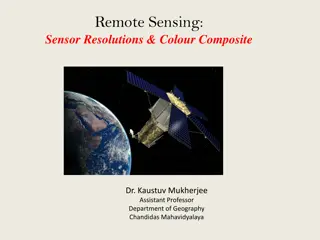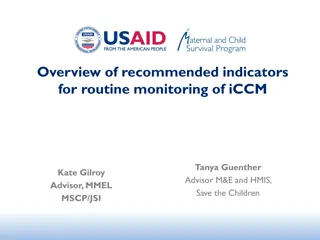Handbook on Cyclical Composite Indicators Overview
This content provides insights into cyclical composite indicators, their objectives, features, and importance in economic analysis. It emphasizes the need for harmonized principles and standards in compiling these indicators for better international comparisons and economic assessments. The handbook outlines key methodologies and steps for countries aiming to establish cyclical measurement systems. Collaborative efforts from various organizations were involved in drafting the handbook, demonstrating a comprehensive approach to compiling these essential indicators.
Download Presentation

Please find below an Image/Link to download the presentation.
The content on the website is provided AS IS for your information and personal use only. It may not be sold, licensed, or shared on other websites without obtaining consent from the author.If you encounter any issues during the download, it is possible that the publisher has removed the file from their server.
You are allowed to download the files provided on this website for personal or commercial use, subject to the condition that they are used lawfully. All files are the property of their respective owners.
The content on the website is provided AS IS for your information and personal use only. It may not be sold, licensed, or shared on other websites without obtaining consent from the author.
E N D
Presentation Transcript
Introduction to the handbook on cyclical composite indicators Regional workshop on short-term economic indicators and service statistics to support 2008 SNA implementation 25-27 September 2017 Chiba, Japan Herman Smith United Nations Statistics Division
Outline of presentation Introduction to cyclical composite indicators Objectives The Handbook Outline Status and way forward 2
Introduction to cyclical composite indicators What are cyclical composite indicators? Are a large family of indicators measuring different aspects of economic activity Are formed by combining other statistical indicators Features Have different timings Serve various purposes Are based on a variety of statistical/econometric methods Rely on various data sets Quantitative statistical variables Qualitative variables Financial indicators 3
Objectives Provides statistical guidance on harmonized principles for application in the formulation of cyclical composite indicators and standards for their compilation and presentation Assists compilers in producing cyclical composite indicators in a comparable way, to enable reliable international comparisons of economic performance and behaviour using the best international practices 4
Objectives Assists countries that plan to set up a comprehensive system of cyclical measures by Providing the methodological foundations for business or growth cycle compilation Offering practical guidance on individual steps and elements of the compilation process Serves the needs of producers of short-term statistics and analytical users by making them aware of the statistical methods and techniques employed in the construction of composite indicators 5
The Handbook Working group was established to prepare handbook: Statistics Netherlands (lead) Eurostat The Conference Board United Nations Statistics Division Experts from these organizations drafted the various chapters in the handbook Conference calls were organized and email communications were used to discuss and clarify issues and progress 6
Outline 8 sections comprising 22 chapters 7
Outline Section 1: Introduction and definitions Chapter 1: Introduction and overview of the handbook Discusses the objectives and structure of the handbook Provides short overview of the usefulness of cyclical composite indicators Chapter 2: A brief history of business cycle measurement and analysis Discusses various exogenous and endogenous theories of cyclical fluctuations Chapter 3: Definitions and taxonomy of indicators Discusses various ways to classify the indicators Surveys alternative methodological approaches to construct cyclical composite indicators Applies the various approaches to selected countries 8
Outline Section 2: Data requirements Chapter 4: Data availability, frequency and adjustment techniques Discusses how statistical agencies handle various data issues: Missing data Data unavailability at a desired frequency Proxies Seasonal and calendar adjustment Deflation Backcasting 9
Outline Section 3: Variables and models selection techniques Chapter 5: Review of parametric and non- parametric variable and model selection techniques Describes various approaches to select variables and models Presents and compares the advantages and drawbacks of the alternative techniques Applies the various approaches to actual data sets Chapter 6: Unbalanced large versus small data sets Describes how to work with large and small unbalanced data sets to construct cyclical composite indicators and to forecast real GDP growth 10
Outline Section 4: Indicators measuring cyclical movements Chapter 7: An overview Provides an outline of the section with a description of the structure of the chapters Chapter 8: The Conference Board approach Describes The Conference Board s approach to constructing cyclical composite indicators in terms of Choice of reference cycle Selection of variables Approach to aggregation Compares the similarities and differences between The Conference Board s approach and the original NBER s approach 11
Outline Section 4: Indicators measuring cyclical movements Chapter 9: De-trending methods: parametric views versus non-parametric and univariate versus multivariate Reviews the literature on the methods to perform de- trending and cycle extraction Classifies the various methods and discusses their advantages and drawbacks Provides an illustrative application to de-trending Euro-area GDP in real-time 12
Outline Section 4: Indicators measuring cyclical movements Chapter 10: The OECD approach Describes the purpose of the OECD system of composite leading indicators, including a discussion of its definition, scope and intended audience Discusses the improvements and changes that have been made since its introduction Provides a step-by-step guide to the techniques used in the construction of the composite leading indicators Provides a summary on how to present the composite leading indicators 13
Handbook on cyclical composite indicators Section 4: Indicators measuring cyclical movements Chapter 11: The Stock and Watson approach Introduces the model-based (probabilistic) Stock and Watson approach to constructing cyclical composite indicators Provides the historical elements and main motivations to the development of the work Describes how to select variables and specify models Describes advantages and disadvantages of the approach 14
Handbook on cyclical composite indicators Section 5: Indicators for turning points detection Chapter 12: An overview Provides an outline of the section with a description of the structure of the chapters Chapter 13: Alternative models for cyclical turning point indicators Presents an overview of the alternative time series based and regression-based non-linear techniques and binary regression techniques to construct turning points composite indicators Describes advantages and drawbacks of each approach with a focus on the trade-offs between timeliness and reliability and the risk of false signals 15
Handbook on cyclical composite indicators Section 5: Indicators for turning points detection Chapter 14: Composite cyclical indicators detecting turning points within the ABCD framework Discusses the advantages of monitoring together several kinds of cycles by using the ABCD approach or the extended AB CD approach Describes methodology for dating chronology with examples for the Euro area Describes indicators in detail, including methodology, component variables and models used to develop them Chapter 15: Probit Logit Discusses in detail the use of regression techniques to construct turning points indicators Focuses mainly on the logit and probit approaches, their features, and advantages and drawbacks 16
Handbook on cyclical composite indicators Section 6: Indicators measuring economic growth Chapter 16: An overview Provides an outline of the section with a description of the structure of the chapters Chapter 17: Factor vector autoregressive (VAR) based models: automatic leading indicators Evaluates and compares the forecasting ability of variable reduction and variable selection methods using small and large datasets Discusses the results of applying the methods to predicting the growth rate of industrial production in the Euro area 17
Handbook on cyclical composite indicators Section 6: Indicators measuring economic growth Chapter 18: Large-scale factor models Reviews the literature on large-dimensional dynamic factor models for constructing business cycle indicators and for predicting economic activity Reviews the techniques to overcome issues inherent in economic statistics such as delays in releases, revisions, differences in frequency, non-synchronous releases Chapter 19: Regression, principal components and small scale factors based models Discusses how to apply regression models using principal components to give early estimate of quarterly GDP growth in the coincident quarter Discusses data issues 18
Handbook on cyclical composite indicators Section 7: Validation Chapter 20: An overview Provides an outline of the section Chapter 21: Validation of indicators Discusses issues related to the construction of a real-time database and usefulness of a real-time database in validating cyclical composite indicators Describes how to build up a real-time exercise to validate cyclical composite indicators and examine vintage databases Discusses how the use of leading-coincident-lagging structure to validate indicators 19
Handbook on cyclical composite indicators Section 8: Guidelines for the construction of cyclical composite indicators Chapter 22: Guidelines for the construction of cyclical composite indicators Discusses best practices in constructing cyclical composite indicators Presents a step-by-step operational guide to constructing cyclical composite indicators 20
Status and way forward Preparation process Expert group reviewed draft chapters Global consultation February/March 2016 Revisions of the draft by Eurostat and UNSD Summer 2017: submission for publication The handbook is available online at: https://unstats.un.org/unsd/nationalaccount/consult ationDocs/KS-GQ-17-003-EN-N.pdf Consultative and transparent drafting process! 21
Thank you 23























